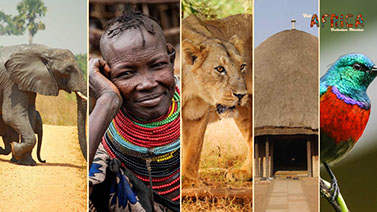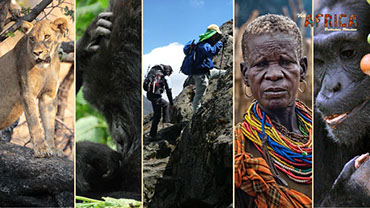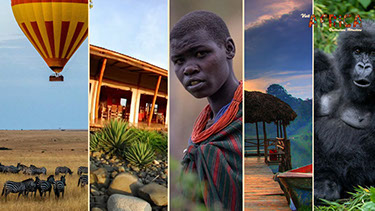Buffalo in Africa
African Buffalo
Scientific Name:
Syncerus caffer
Weight:
About 300 to 835 kilograms (660 to 1,840 pounds)
Size:
About 1 to 2 meters tall (4 to 5 feet)
Life span:
11 to 22 years in the wild
Diet:
Herbivorous
What is an African Buffalo?
African buffalo is the only species of wild cattle that can be found in Africa. It is also known as Cape buffalo, forest buffalo and Savannah buffalo. African buffalo inhabits sub-Saharan parts of Africa. There are four subspecies of African buffalo that differs in colour, size and type of habitat where they can be found. African buffalo lives in open woodlands, Savannah, forests, and lowland rainforests. Since African buffalo depends on water, it requires habitats that receive at least 10 inches of rain per year. African buffalo is sensitive to habitat loss, hunt and diseases (induced by rinderpest virus), but it is not endangered.
The African buffalo or Cape buffalo (Syncerus caffer) is a large Sub-Saharan African bovine. The Cape buffalo, is the typical subspecies, and the largest one, found in Southern and East Africa. S. c. nanus (African forest buffalo) is the smallest subspecies, common in forest areas of Central and West Africa, while S. c. brachyceros is in West Africa and S. c. aequinoctialis is in the Savannah of East Africa. Both males and females have heavy, ridged horns that grow straight out from the head or curve downward and then up. The horns are formidable weapons against predators and are used when jostling for space within the herd; males use the horns in fights for dominance. The adult buffalo's horns are its characteristic feature: they have fused bases, forming a continuous bone shield across the top of the head referred to as a "boss". They are widely regarded as among the most dangerous animals on the African continent, and according to some estimates they gore, trample, and kill over 200 people every year.
Buffalo are considered one of the “big five,” a term grouping them with leopards, rhinoceroses, elephants, and lions as the most dangerous animals to hunt in Africa. Hunting websites refer to the buffalo as “black death” for its dangerous personality—they’re known to be grumpy and unpredictable. And they can run up to 37 miles per hour. Because of this, they’re considered prize trophies by big game hunters.
Wildlife in Africa

+256 760 038002 | +256 753 456707
info@visitafrica.site
.jpg?crc=477344797)
Where do Buffalo Live?
Buffalo are hardy critters, able to live and flourish in many habitats from semi-arid bushland to coastal Savannah to lowland rainforests as long as they’re close to a water source. African Buffalo habitats are found starting in southwest Ethiopia and through Kenya, Uganda, Rwanda, Tanzania, Zambia, and Malawi, with patchier distribution through Angola, Mozambique, and Swaziland. They’re also present in South Africa, and along the southwest coast in countries like the west African countries of Guinea, Sierra Leone, Liberia, Ivory Coast, Ghana, Benin and the southern part of Burkina Faso. They inhabit a wide range of habitats, including semi-arid bushland and montane grasslands to coastal Savannah and lowland rainforests as long as they are close to a water source. In general, they are distributed throughout sub-Saharan Africa and are found throughout the northern and southern Savannah as well as the lowland rainforest.
What are the Behaviours of African Buffalo?
Buffalo live in herds of a few hundred but have been known to congregate in thousands in the Serengeti in Tanzania, in Uganda, Kenya, Zambia, Malawi and South Africa during the rainy season. Congregating in large herds is one of their many anti-predator adaptations. Large herds decrease the possibility of any individual being singled out by lions. The females and their offspring make up the bulk of the herd. Males may spend much of their time in bachelor groups. These groups are of two types, those that contain males from 4 to 7 years old and those that have males 12 years and older. The older bulls often prefer to be on their own.
Their sight and hearing are both rather poor, but their scent is well developed in African buffalos. They also seem to have a relatively difficult time regulating body temperature, the reason why they feed mostly at night. Although they are quiet for the most part, the animals do communicate. In mating seasons they grunt and emit hoarse bellows, and a calf in danger will bellow mournfully, bringing herd members running at a gallop to defend it.
.jpg?crc=3967399317)
What do Buffalo eat?
Buffalo Food sources play more of an important role than predation in regulating population numbers. Without fresh green feed, buffaloes deteriorate rapidly. They devote a large portion of their time to grazing and feeding. After grazing on grass, just like cows, they spend time chewing their cud (or bolus) to extract even more nutrients from their food.
.jpg?crc=45374910)
8 Interesting Facts about Buffalo
- African Buffalo do not have very good eyesight but their hearing and especially their smell is exceptional.
- African buffalo is well known for its exceptional memory. It will recognize a person (such as hunters) that hurt it in the past and it will attack it at their next encounter. Same is with lions. They will "preventively" kill cubs of lions that are known attackers of the herd. There are many hunting tales that mention wounded buffaloes setting ambushes for hunters that follow or have attacked them in the past (even years before), by circling back on their own tracks, to stand and wait for the hunters that are tracking them. This has earned them the title "Black Death".
- African Buffalo will often kneel down and rub their necks and heads on the ground in a display of aggression to establish dominance.
- Although not the fastest bovine at 35mph (56kph), African Buffalo can still outrun lions. However, predators can accelerate quicker making the buffalo easy to ambush.
- When faced with predators, animals of the herd form a circle around the young, old or weak animals, exposing their large and sharp horns toward the predators. This barrier is very effective and prevents predators to reach the animals that are not strong enough to fight.
- The African buffalo has a symbiotic relationship with many African birds such as the Oxpecker.
- They are often found eating insects off the buffalo and will also warn the buffalo of approaching danger.
- Horns of African buffalo are shaped like question marks. Males have longer and thicker horns.
Architect Tourism SMC Ltd is an African tourism company, crafted to inspire and enable a breathtaking beautiful experience of Africa. Visit Africa is one of Architect Tourism SMC tourism brands. Visit Africa is inspired to craft innovative, fun and breathtaking tourism events, trips, excursions, getaways, safari, vacations, holiday, and tours experiences.
Vision: To inspire, craft, and enable a breathtaking beautiful experience of Africa.
Our Values: African, Oneness, Integrity, Client focused, Conservation focused, Innovative, Excellence, Simplicity.
Company Registration Number: 80020002986484 | Company Tax ID: 1018106912

Visit Africa is an African tourism brand, that profiles every tourist destination, in every country, in Africa; Destinations, How to get there, Attractions, Things to do, How to get around, itinerary pricing and Where to stay, for an adventurous breathtaking and thrilling experience of tourism of Africa.
Visit Africa
Destinations
Visit Namibia
We are Social!
Search this website!
Africa
Visit Africa
Visit Uganda
Visit Tanzania
Visit Zimbabwe
Visit South Africa
Visit Kenya
Visit Morocco
Tour Itineraries











Visit Africa Copyright © 2019 - Visit Africa is a Tourism Brand of Architect Tourism SMC Limited.
Wildlife in Africa
Visit Egypt

Visit Rwanda
Visit Africa's Tourism Events

Uganda Wildlife, Nature, City life & Cultural Tourism Event Experience
8 days | 3 Major Destinations | 6-25 Travellers
From $1,800




